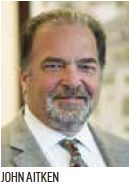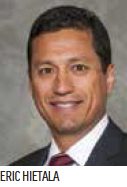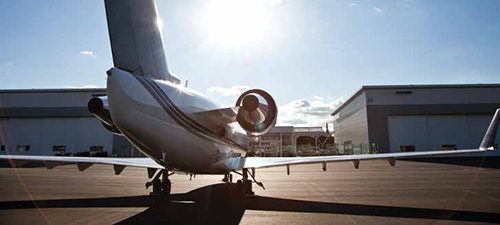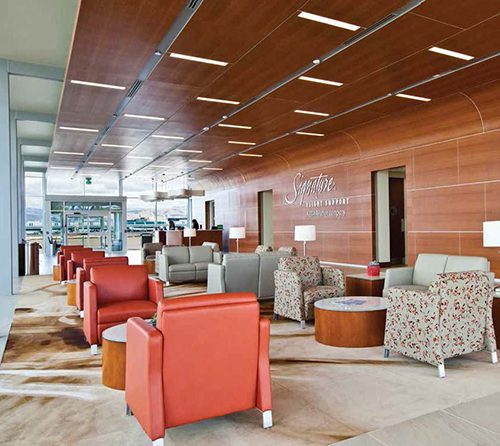When Signature Flight Support opened a new $82 million corporate aviation facility at Norman Y. Mineta San Jose International (SJC) in early November, airport officials were thrilled to have a second fixed base operator on the field. They also viewed the new tenant as a larger symbol of what is and has been happening at the airport that serves California’s Silicon Valley.
One of the primary tenants at the new facility is Blue City Holdings, which represents the principals of Google. In fact, the company financed a significant portion of the hangar development, reports Signature.
 facts&figures facts&figuresProject: Fixed Base Operation Location: Norman Y. Mineta San Jose Int’l Airport Owner/Operator: Signature Flight Support Cost: $82 million (100% privately financed) Building Size: 270,000 sq. ft. Lot Size: 29 acres Design Architect: Gensler Architect of Record: Shenkel Schultz Contractors: Weitz Co.; Granite Construction |
John Aitken, SJC’s assistant director of aviation, notes that recent investments by Signature and Blue City have prompted a collective “moment of realization” for the airport and community regarding the impact that the local tech community can have on aviation (and vice versa).
“To motivate Signature to invest that much money in our community means that they also saw something here beyond our 33,000 annual general aviation operations,” Aitken explains. “It was a moment of pride for us.”
The new 270,000-square-foot facility includes an executive passenger terminal, seven hangars, ramp space to accommodate large business jets and aircraft servicing facilities. Signature, a subsidiary of BBA Aviation, committed to a 50-year lease.
According to Aitken, the new facility represents the largest private investment on the airfield by “many millions.” It’s also a well-timed sequel to the $1.3 billion modernization program SJC completed in mid-2010.
Rent for the 29 acres Signature leases will add $2.6 million per year to SJC’s ledger. “Getting the maximum value for every acre is key for us,” Aitken comments, noting that the airport has only 1,000 acres total.
In addition to significant rent revenue, Signature guarantees of $400,000 in annual fuel flowage fees to the airport. The city of San Jose stands to gain as well – $70,000 in tax revenue the first year and $300,000 the fifth year and beyond. “The revenue package for both the airport and city was very impressive and is going to work very well for us,” Aitken comments.
Signature’s new facilities have added 36 permanent jobs at the airport. Officials further estimate that 150 to 200 construction jobs were supported while the facility was being built, and about 370 direct and indirect jobs will be created thanks to Signature’s arrival.
 Airfield Reorganization
Airfield Reorganization
The land that the new facility occupies became available when SJC relocated employee and long-term customer parking lots during its $1.3 billion modernization program. By moving the parking lots from the west side of the airport to the east, 44 acres were opened up for development. The airport also saved money on bussing costs, because the lots were moved closer to the passenger terminals.
SJC officials issued a request for proposals to develop the newly available land in April 2012. The airport purposely took a broad approach to the request, inviting proposals for any use allowed under its master plan to elicit a variety of ideas for developing the acreage, explains Aitken. “We were looking for the highest value and best use of the land,” he elaborates.
The airport will likely take a similarly open-ended approach when seeking proposals for the remaining acreage.
Prior to Signature’s proposal prevailing, SJC had one fixed base operator: Atlantic Aviation – a company that has done a great job taking care of the business community at the airport, notes Aitken. The need for additional corporate services became evident as corporate demand increased over the years, he adds. “We have a lot of positive things happening here,” Aitken explains. “The corporate market was trending upward, so we knew we needed to expand facilities and support growth in operations.”
 According to airport statistics, 105 companies reside within 18 miles of SJC. Together, they represent $628 billion in global sales and $39.3 billion in capital expenditures.
According to airport statistics, 105 companies reside within 18 miles of SJC. Together, they represent $628 billion in global sales and $39.3 billion in capital expenditures.
Eric Hietala, Western Region vice president for Signature, says that the worldwide fixed base operator network saw a tremendous opportunity at SJC. “(The company) thought the aviation and larger community could be better served by competition on the field,” says Hietala.
“We are space constrained, but these two facilities [Signature and Atlantic] are going to be able to push a lot of aircraft through a small footprint,” Aitken notes.
In fiscal year 2014, SJC’s general aviation operations numbered about 29,600, and volume increased to 33,200 in fiscal year 2015. “We anticipate those numbers will continue to grow,” Aitken adds.
Growing Opportunities
“Atlantic Aviation has served our general aviation and business community well for many years,” relates Rosemary Barnes, A.A.E., public relations manager for SJC. “They’ve been an amazing partner and tenant for us. However, the time had come when we needed to support the growing private aviation needs of local high-tech and other companies, and Signature was the right company at the right time.”
In addition to bringing customers and based aircraft to the field, Signature Flight Support also relocated its Western Region headquarters and associated managers, accounting and human resource personnel to SJC. “The location is very significant for us,” notes Hietala.
The company saw a tremendous opportunity for growth potential due to pent-up demand in an underserved area, he explains. “The market was looking for additional competition. Silicon Valley as a whole is growing,” he relates.
San Jose fits well into Signature’s portfolio of more than 100 other locations, because Silicon Valley was previously a “major void” in the network the company wanted to fill, notes Hietala.
 “Signature also saw the growing investment in our community from the sports and entertainment industry,” Barnes adds. The new Avaya Stadium, built for Major League Soccer’s San Jose Earthquakes, sits directly across the street from the airport. Nearby Levi’s Stadium, new home of the San Francisco 49ers, will host Super Bowl 50 in early 2016.
“Signature also saw the growing investment in our community from the sports and entertainment industry,” Barnes adds. The new Avaya Stadium, built for Major League Soccer’s San Jose Earthquakes, sits directly across the street from the airport. Nearby Levi’s Stadium, new home of the San Francisco 49ers, will host Super Bowl 50 in early 2016.
 Conducive for Construction
Conducive for Construction
Because the project site was formerly a parking lot, it didn’t require much preparation. Signature removed asphalt, concrete curbs and some light poles and developed the parcel to its needs. The nearly greenfield site with plenty of room to operate allowed Signature to move the project along aggressively, without phasing, Hietala reports. “We believe that was a wise decision, because now we have a high degree of interest in all of the hangar and ramp facilities,” he adds.
Slight airside modifications – the addition of two S turns in a taxiway – were needed to meet FAA standards that prevent straight-on access from ramp to runway. Per Signature’s original proposal, it assumed the responsibility and cost of initial capital investments for the taxiway reconfiguration; SJC will maintain the pavements going forward.
While much of the facility construction was physically separated from airfield operations, tying the new facility into the movement area required careful coordination. SJC repurposed a small runway into a taxiway to allow construction crews room to work in the movement area without impeding general aviation traffic. Because SJC’s two fixed base operators are fairly close to each other, tearing up the movement area in front of the new Signature facility would have also impacted Atlantic Aviation. “By using that small runway as a taxiway, we were able to eliminate that impact to Atlantic’s operation and to all the corporate aircraft that were arriving and departing during the construction period,” Aitken explains.
Facility Highlights
The new 270,000-square-foot facility, designed by Gensler, is tailored to meet the needs of Silicon Valley companies. (Gensler also served as the master architect for the airport’s larger terminal renovation program.)
“We’re really addressing what we believe has been pent-up demand,” comments Hietala. Over the years, aircraft operations that would have preferred to be based in San Jose migrated out to the Central Valley and Monterey due to a shortage of hangar space and competition at SJC, he explains. “One of our goals is to bring that traffic back to San Jose.”
 Hietala considers the 60,00-square-foot Hangar 7 the facility’s most notable feature. The partnership with and investment by Blue City Holdings helped Signature build a facility that is “unprecedented in size and scope” in the company’s entire network. “We’re very fortunate to work with such an organization,” says Hietala.
Hietala considers the 60,00-square-foot Hangar 7 the facility’s most notable feature. The partnership with and investment by Blue City Holdings helped Signature build a facility that is “unprecedented in size and scope” in the company’s entire network. “We’re very fortunate to work with such an organization,” says Hietala.
Another noteworthy facility feature is an open-air technology garden that extends from the executive terminal. The 7,000-square-foot exterior space is filled with drought-resistant plants and exhibits from the Tech Museum of Innovation and Computer History Museum. “It’s very unusual for an FBO to have an adjacent, exterior space where customers are able to enjoy the 330 days of sunshine that you have in the South Bay,” Hietala remarks.
 Pervasive use of light is an overall hallmark of the facility’s architecture, he notes. Large picture windows provide views of the technology garden, and a row of windows lining the top portion of the hangar doors allows natural light to illuminate the space. In addition to creating a bright ambience, the design is expected to decrease the amount of energy used for electric lighting.
Pervasive use of light is an overall hallmark of the facility’s architecture, he notes. Large picture windows provide views of the technology garden, and a row of windows lining the top portion of the hangar doors allows natural light to illuminate the space. In addition to creating a bright ambience, the design is expected to decrease the amount of energy used for electric lighting.
The heavy use of glass brings in plenty of light during the day and allows the facility to be illuminated like a lantern at night, explains Gensler Design Director Terence Young. “The building is glassy and opens up so that it’s not a mysterious black box,” he remarks.
A canopy shades much of the building to allow filtered light through without heat gain, notes Tim Sullivan, senior associate at Gensler. Native, drought-resistant plants were added to help the facility to blend into the Northern California landscape.
Sustainability is further echoed in the building and finish materials – locally procured, low-VOC products; a metal frame; concrete; glass; and high-efficiency water fixtures.
Signature will seek certification in Leadership in Energy & Environmental Design from the U.S. Green Building Council. “LEED certification is something that is important to BBA Aviation in terms or our corporate social responsibility goals and objectives,” Hietala says. In fact, the first U.S. fixed base operation to achieve LEED certification was Signature’s facility at Boston Logan International.
 Spring-boarding off the emphasis placed on art elsewhere at SJC and within other city-owned facilities, Signature made art a priority in its new space at the airport. The technology garden includes trees, plants and tables, as well as unprogrammed space for artist displays. “It’s sort of like a stage,” Young explains.
Spring-boarding off the emphasis placed on art elsewhere at SJC and within other city-owned facilities, Signature made art a priority in its new space at the airport. The technology garden includes trees, plants and tables, as well as unprogrammed space for artist displays. “It’s sort of like a stage,” Young explains.
“We see this as an opportunity to put in a kind of boutique, high-end facility and marry that with aviation and with the workplace to come up with a very interesting and creative place for private aviation to work from,” Sullivan adds.
Sharing the airport’s perspective, Barnes is in complete agreement: “Signature built a beautiful and impressive facility representing both SJC and the Silicon Valley community.”
 Establishing Roots
Establishing Roots
In its proposal to develop space at SJC, Signature committed to a variety of local investments. Aitken explains that it seemed important to Signature to demonstrate that it won’t be a company that simply occupies space at the airport, but a company that will become part of the local community.
One of the benefactors is San Jose State University, which will receive “relevant experience” at the airport facility for its students. In an entirely different vein, the nearby Computer History Museum will benefit by gaining space to display pieces that highlight the importance of Silicon Valley.
“Signature wants to be more than just an FBO,” Hietala says. “We want to be part of the fabric of the community.”
Thinking even farther beyond the airport fence, Signature is contributing to local nonprofit organizations. “We recognize that we have a long lease here in 50 years,” says Hietala. “With that brings certain obligations to the greater community.”




